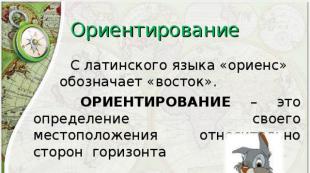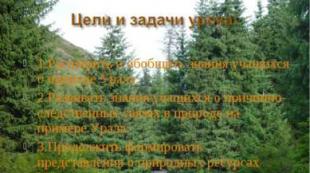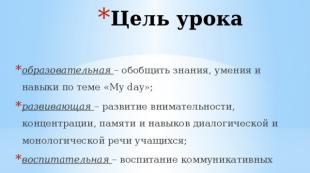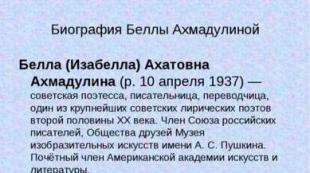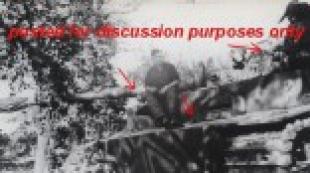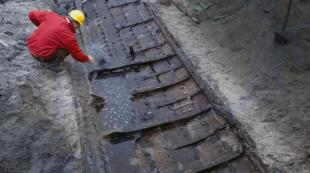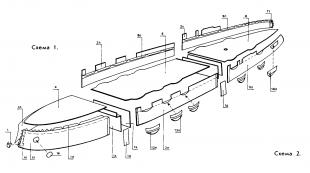The Urals are the stone belt of the Russian land. Ural - "stone belt" of Russian land Ural stone belt of Russian land presentation
Slide 1
Final lesson on the topic: “Ural” 8th gradeSlide 2
 1.Expand and generalize students’ knowledge about the nature of the Urals. 2. To develop students’ knowledge of cause-and-effect relationships in nature using the example of the Urals. 3. Continue to form ideas about the natural resources of the Urals and their use.
1.Expand and generalize students’ knowledge about the nature of the Urals. 2. To develop students’ knowledge of cause-and-effect relationships in nature using the example of the Urals. 3. Continue to form ideas about the natural resources of the Urals and their use.
Slide 3
 1. Along which meridian are the Ural Mountains located? 2.Which plain is located west of the Urals? 3.What is the name of the highest peak of the Urals? 4. What era of folding is associated with the formation of the Urals? 5.What are the main natural resources of the Urals? 6.What ornamental stones are found in the Urals? 7.What is the name of the mineralogical reserve in the Urals? 8. What minerals are found in Magnitogorsk and Kachkanar? 9.What fossil fuels are mined in the Urals? 10.What is the length of the Ural Mountains?
1. Along which meridian are the Ural Mountains located? 2.Which plain is located west of the Urals? 3.What is the name of the highest peak of the Urals? 4. What era of folding is associated with the formation of the Urals? 5.What are the main natural resources of the Urals? 6.What ornamental stones are found in the Urals? 7.What is the name of the mineralogical reserve in the Urals? 8. What minerals are found in Magnitogorsk and Kachkanar? 9.What fossil fuels are mined in the Urals? 10.What is the length of the Ural Mountains?
Slide 4
 1. Along which meridian are the Ural Mountains located? (60°E) 2.Which plain is located west of the Urals? (Russian Plain) 3.What is the name of the highest peak of the Urals? (city of Narodnaya) 4. What era of folding is associated with the formation of the Urals? (Hercynian) 5.What are the main natural resources of the Urals? (mineral resources - ores) 6. What ornamental stones are found in the Urals? (malachite, jasper, etc.) 7. What is the name of the mineralogical reserve in the Urals? (Ilmensky) 8. What minerals are found in Magnitogorsk and Kachkanar? (iron ores) 9. What fossil fuels are mined in the Urals? (oil and gas) 10.What is the length of the Ural Mountains? (2000 km).
1. Along which meridian are the Ural Mountains located? (60°E) 2.Which plain is located west of the Urals? (Russian Plain) 3.What is the name of the highest peak of the Urals? (city of Narodnaya) 4. What era of folding is associated with the formation of the Urals? (Hercynian) 5.What are the main natural resources of the Urals? (mineral resources - ores) 6. What ornamental stones are found in the Urals? (malachite, jasper, etc.) 7. What is the name of the mineralogical reserve in the Urals? (Ilmensky) 8. What minerals are found in Magnitogorsk and Kachkanar? (iron ores) 9. What fossil fuels are mined in the Urals? (oil and gas) 10.What is the length of the Ural Mountains? (2000 km).
Slide 5
 ...Ural! The supporting edge of the state, Its breadwinner and blacksmith, The same age as our ancient glory and the creator of our present glory! A.T. Tvardovsky
...Ural! The supporting edge of the state, Its breadwinner and blacksmith, The same age as our ancient glory and the creator of our present glory! A.T. Tvardovsky
Slide 6
 Borderline Geographical position 1. Between two parts of the world 1. Deep position 2. Between different parts of the earth's crust. 2. Position on the border 3. Between the various forms of European and Asian relief. 4. Between the basins of the largest rivers. 5. Between climatic zones and regions. 6. Between several natural areas. Main factors
Borderline Geographical position 1. Between two parts of the world 1. Deep position 2. Between different parts of the earth's crust. 2. Position on the border 3. Between the various forms of European and Asian relief. 4. Between the basins of the largest rivers. 5. Between climatic zones and regions. 6. Between several natural areas. Main factors
Slide 7
 GP factors position inside the continent elongation from north to south accessibility to winds from the Arctic Ocean
GP factors position inside the continent elongation from north to south accessibility to winds from the Arctic Ocean
Slide 8
 You raised a stony skeleton Above the ancestral deserts of vanished years. Grinding by the winds, for centuries Your stone has been worn down to the foot. The dust was blown away like a shroud on the hidden hillocks of the ancient ridges, and no trace remained of the heights - only the depths were ancient, and there was ore in the depths. The steep peaks celebrate housewarming, The rivers cut into the gorges are young, The streams are young to dig for ores, The keys to ancient riches are young Yu.K. Efremov
You raised a stony skeleton Above the ancestral deserts of vanished years. Grinding by the winds, for centuries Your stone has been worn down to the foot. The dust was blown away like a shroud on the hidden hillocks of the ancient ridges, and no trace remained of the heights - only the depths were ancient, and there was ore in the depths. The steep peaks celebrate housewarming, The rivers cut into the gorges are young, The streams are young to dig for ores, The keys to ancient riches are young Yu.K. Efremov
Slide 9

Slide 10
 “If you look at the mountain from afar, it seems that its entire slope is covered with small crushed stone, like paving stones. These are stone placers - kurums. To climb the mountain by scattering, you will have to climb from stone to stone for a long time. When you climb to the top of the mountain, a majestic picture appears before you: the placer is sliding down in a continuous gray mass of boulders, as if poured out of a huge bag by some giant. The edges of the placer are usually overgrown with bushes of honeysuckle, bird cherry, raspberry, fireweed, and here and there Siberian cedars, mountain spruces and firs rise.” (According to D. Maminy-Sibiryak).
“If you look at the mountain from afar, it seems that its entire slope is covered with small crushed stone, like paving stones. These are stone placers - kurums. To climb the mountain by scattering, you will have to climb from stone to stone for a long time. When you climb to the top of the mountain, a majestic picture appears before you: the placer is sliding down in a continuous gray mass of boulders, as if poured out of a huge bag by some giant. The edges of the placer are usually overgrown with bushes of honeysuckle, bird cherry, raspberry, fireweed, and here and there Siberian cedars, mountain spruces and firs rise.” (According to D. Maminy-Sibiryak).
Slide 11

Slide 12

Slide 13
 Rivers of the Urals flowing into the Russian Plain flowing into the West Siberian Lowland 1. Vishera 1. Shchuchya (tributary of the Ob) 2. Usa (tributary of the Pechora) 2. Tura (tributary of the Tobol) 3. Shchuger (tributary of the Pechora) 3. Sosva 4. Kosva (tributary of the Kama), etc. 4. Son, etc.
Rivers of the Urals flowing into the Russian Plain flowing into the West Siberian Lowland 1. Vishera 1. Shchuchya (tributary of the Ob) 2. Usa (tributary of the Pechora) 2. Tura (tributary of the Tobol) 3. Shchuger (tributary of the Pechora) 3. Sosva 4. Kosva (tributary of the Kama), etc. 4. Son, etc.
Slide 14
 Determine which areas the following characteristics apply to. Write the answer in numbers. 1. Here is the highest part of the Urals. 2. Winter lasts eight months, and a short, gloomy summer with the sun never setting beyond the horizon lasts only two months. 3. Taiga seems silent and gloomy here. Krasnovishersk and Ivdel are the largest cities here. 4. The nature of this part of the Urals has been most changed by man. Small old factories have now become large centers of industry. 5. Low foothills give way to individual mountains - remnants, among them the famous Magnitnaya. 6. On warm days, mosquitoes dominate the tundra, forcing reindeer to migrate closer to the sea coast, to its refreshing winds. 7. The Pechora River originates in this area. 8. The Ilmensky State Nature Reserve is located in this area. 9. The largest city in the Urals is located. 10. In clear weather, from the flat, destroyed peak of Mount Iremel to the west, a wide panorama opens to the lower chains of mountains, and behind the mountains - the steppes. NAME OF THE AREA ANSWER Polar 2, 6 Subpolar 1 Northern 3, 7 Middle 4, 9 Southern 5, 8, 10 NAME OF THE AREA ANSWER Polar Subpolar Northern Middle Southern
Determine which areas the following characteristics apply to. Write the answer in numbers. 1. Here is the highest part of the Urals. 2. Winter lasts eight months, and a short, gloomy summer with the sun never setting beyond the horizon lasts only two months. 3. Taiga seems silent and gloomy here. Krasnovishersk and Ivdel are the largest cities here. 4. The nature of this part of the Urals has been most changed by man. Small old factories have now become large centers of industry. 5. Low foothills give way to individual mountains - remnants, among them the famous Magnitnaya. 6. On warm days, mosquitoes dominate the tundra, forcing reindeer to migrate closer to the sea coast, to its refreshing winds. 7. The Pechora River originates in this area. 8. The Ilmensky State Nature Reserve is located in this area. 9. The largest city in the Urals is located. 10. In clear weather, from the flat, destroyed peak of Mount Iremel to the west, a wide panorama opens to the lower chains of mountains, and behind the mountains - the steppes. NAME OF THE AREA ANSWER Polar 2, 6 Subpolar 1 Northern 3, 7 Middle 4, 9 Southern 5, 8, 10 NAME OF THE AREA ANSWER Polar Subpolar Northern Middle Southern
Slide 15
 1. The word “Ural” means “belt”. Is this name justified? Prove it. 2. Compare the western and eastern slopes of the Urals using a physical map. What is their difference? Explain. 3. Why is the Middle Urals the richest in mineral resources? 4. In the city of Zlatoust, the annual precipitation amount is 540 mm, in Chelyabinsk - 390 mm, despite the fact that these cities lie on the same geographical latitude. How can we explain this difference?
1. The word “Ural” means “belt”. Is this name justified? Prove it. 2. Compare the western and eastern slopes of the Urals using a physical map. What is their difference? Explain. 3. Why is the Middle Urals the richest in mineral resources? 4. In the city of Zlatoust, the annual precipitation amount is 540 mm, in Chelyabinsk - 390 mm, despite the fact that these cities lie on the same geographical latitude. How can we explain this difference?
Slide 16

Ural - stone belt Russian land .

He's on the Asian mainland
Came across a stone threshold
He knows the mammoth skeleton
In frozen soils. Showers, winds
It has been sharpened for millions of years,
So that the edges sparkle like a line.
Iron, nickel, chrome ores
I will touch you with a word, I will find a rhyme for it.
No wonder there is an emerald stone in the mines
He looks into the darkness with his green eye.
The ridge will confuse the trail of elk,
He will begin to regale you with ripe blueberries,
The Sosvaya River will flash between the pines,
The glacier will reach the bright cloud,
He will look into the lakes and enter poetry like this.
He smelled of forests and flowers
And bitter factory smoke.
S. Shchipachev

The Ural is a mountainous country,
stretching from the
the Kara Sea region to
steppes of Kazakhstan from the north
ra to the south more than 2000 km, with
west to east – from 50

Continuation of the Ural Mountains
in the north are the islands
Novaya Zemlya and Vaygach, and on
south of the Mugojar Mountains.

The Urals are natural
border between Europe

were called Riphean.
"Stone Belt of the Russian Land"
“Stone”, “Earth belt” - so on
was called the Urals until the 18th century.

The name "Ural" appears with
from the 18th century In the works of the Russian historian
Rick and geographer Vasily Nikiti-
cha Tatishchev (“ur” in Mansi,
and “ure” in Even means

The Ural Mountains rise
before the eyes of the ridges of the middle
low-altitude ridges and quacks
zhey, dressed in taiga.

The highest point of the Urals
of the mountains - Mount Narodnaya

Mountains consist of several
drink, which stretch parallel-
but to each other in the meridian
direction. The ridges are divided
longitudinal intermountain ponies
marriages through which rivers flow.
Transverse valleys dissect
these chains into separate ridges and

History of development Ural.

- People settled in the Urals and moved gradually along the mountain steppes to the edge of the glacier.
- The ancient population of the Urals - the ancestors of the Udmurts, Komi, Khanty and others in the primitive era created a rich and unique culture.

- The first people spoke the language of the modern Khanty and Mansi peoples. The Abashev tribes lived in the steppes of the Southern Urals, as well as in the Chelyabinsk region.

Bashkir village
- The main population of the Southern Urals is IX – XI centuries were Bashkirs.
- From the second half XVI century, Bashkiria became a vassal of the Moscow state.
- The first Bashkir villages began to appear.

Cossacks
- IN XVI V. on the river In the Urals, free people appear who create a “Cossack republic” here.
- IN XVII V. The Orenburg Cossacks formed in the Southern Urals.

Construction of fortresses
- In 1730-1750 The first Russian settlements arose near the area of present-day Miass: Chebarkul, Kundravinskaya, and Uyskaya.
- The government's task was to build fortresses in the Southern Trans-Urals, which led to an influx of peasants and service people.

Ancient inhabitants of the Urals
there were Bashkirs, Udmurts, Komi,
Khanty, Mansi, local Tatars.

The first settlements of Russians in the
curled in the Urals in the upper reaches of Ka-
we, their inhabitants, were engaged in hunting
that and fishing. In the 11th century By-
sad people Kalinnikovs-
we created the first salts
Varni in the village of Sol-Kamskoye
(modern Solikamsk).

XVIII century – century of mining plant development
industry of the Urals.
Studying natural resources
Ural, is engaged in their description
at this time V.N. Tatishchev. He
new the need for construction
tva of a large industrial plant
ntra of the Urals and chose me-
one hundred. This is how Catherine-

Geological research
tion of the Urals is actively
lived in the 19th century in I.V. Mushka-
Tov, A.E. Fersman and others.

Mining industry
studied the lands of the Urals and
could improve
scientist D.I. Mendeleev.

About the fabulous riches of the Urals
told brightly and colorfully in
his tales about the mistress Copper
mountains P.P.Bazhov.

“Ural! The supporting edge of the state,
Her breadwinner and blacksmith,
The same age as our ancient
And the creator of present glory"
(A. Tvardovsky)

Natural resources Ural.

The Urals amazes with the wealth of its
subsoil The Urals are called a pantry
countries. About 1000 found here
various minerals and taken into account
over 10 thousand p/i deposits.
In terms of reserves of platinum, asbestos, ore-
precious stones, potassium salts
The Urals own one of the
best places in the world.

Working with the map.
1. Between what tectonic structures
is the Urals located?
2. What structure separates the Urals from the Russian plateau?
3. What kind of mineral resources does the region contain?
howling trough of the Urals?

Ancient mountains of the Urals,
formed in the Paleozoic,
during the Mesozoic and Pale-
ogen were almost completely
thu destroyed. In the Neogene
Quaternary time current
tonic movements under
lifted to different heights
separate blocks of the Urals.
This is how folded
blocky Ural mountains

Ural fold system
Russian platform
West Siberian Plate

Stages of the origin of the Ural Mountains.
Stage 1.
Archean and Proterozoic era .
Stage 2. Palaeozoic. (Hercynian folding)
Stage 3. Mesozoic era.
4 stage . Cenozoic era.

After this, the mountains were again subjected to
destruction as a result of activities
ity of external forces - weathering,
activities of rivers and ice. As a result-
those near the surface turned out to be internal
removing parts of the folds where intense
processes of mineral formation took place,
various ores arose.

As a result of weathering
education occurs
kurums, trogs, circuses,
caves, carts


Cis-Urals
Trans-Urals
Central strip

Relief and geological structure
Salekhard
Sablya (1497)
Solikamsk
Chelyabinsk


Hercynian
folding
ore
useful
fossils
Mid-height
and low
mountains
sedimentary
useful
fossils
hills
Cis-Urals
Russian region
platforms
edge
West Siberian
slabs, fault
ore useful
fossils
Trans-Urals

The main wealth of the Urals is ores,
moreover, complex ores, for example
mer, iron ores with admixture
titanium, vanadium, nickel, chromium.
Copper ores with an admixture of zinc,
gold, silver.
Most ore deposits
it is located on the eastern slope
not where igneous predominates

Magnitogorsk
Vysokogorskoe
Krasnouralskoe
Large ore deposits
Kachkanarskoe
Khalilovskoe
Bakalskoe

The Urals are rich in color deposits
metals.
Copper ore is mined at Krasno-
Ural, Gaisky and other places of
deniyah. In the north of the Urals there were
there are large deposits of bok-
bauxite and manganese.

A lot of nickel is mined in the Urals
and chromium. The oldest place is gold-
mining in Russia – Berezovskoye
deposit near Yekaterinburg-

The following are non-metallic minerals:
no mention of huge deposits
asbestos (“mountain flax”) – valuable
the best fire-resistant material
la. Bazhenovskoye field
asbestos - one of the largest in

The Urals have long been famous for its various
precious and ornamental
with stones. Known Ural
gems: amethysts, smoky
topaz, green emerald,

sapphires, clear rock
crystal, alexandrites, etc.
All these gems are mined
are mined mainly in the re-
exact slope.

On the western slope of the Vishe-
ry found high-quality
new diamonds.

Ornamental stones of the Urals.
jasper
coil
malachite

In the Cis-Ural region, Permian salt-bearing
nye strata of the marginal trough co-
hold large reserves of potash
salts, rock salt, gypsum
(Verkhnekamskoye, Sol-Iletskoye,
Usolskoye field).

There are a lot of construction sites in the Urals
materials – limestone, granite,
cement raw materials. Available in the Urals
also oil (Ishimbay, etc.) and
coal.


In addition to mineral resources
resources The Urals are rich in forests
resources. Especially a lot
forests in the Northern Urals.

false Ural?
2. Determine what differences exist
ut in climatic conditions:
a) Northern and Southern Urals
b) Cis-Urals and Trans-Urals.

1.What water basins do the rivers of the Urals belong to?
2. Which parts of the Urals are well supplied with water resources?

Chusovaya river
Insufficiently provided with water
resources of the Middle Urals.
The main rivers of the Urals: Chusovaya,
Belaya, Ural, Kama.

R. Serebryanka
Waterfall on the Zhigolan River

The harsh beauty of the Polar and Se-
true Urals, exotic wasps
dancing, karst caves Sred-
he and the Southern Urals were attracted
There are many tourists in these areas.
But recreational resources are still
insufficiently mastered.

Nomenclature:
- Relief: Southern Urals, Middle Urals, Northern Urals, Pripo-
polar Urals, Polar Urals, Pai-Khoi ridge, Narodnaya, Konstantin
new Kamen, Telpoz, Denezhkin Kamen, Konzhakovsky
Kamen, Kachkanar, Yamantau, Magnitnaya, Payer.
- Minerals .
- Rivers : Shchuchya, Northern Sosva, Kosva, Tagil, Chusovaya, Ufa,
Yuryuzan, Ural, Belaya, Samara.
K.k. pp. 12-13, atlas pp. 42-43

Photo gallery Ural mountains









, Competition "Presentation for the lesson"
Class: 8
Presentation for the lesson
Back forward
Attention! Slide previews are for informational purposes only and may not represent all the features of the presentation. If you are interested in this work, please download the full version.
Lesson objectives:
- Educational– to introduce students to the uniqueness of the Urals training complex and compare it with the Caucasus.
- Developmental– continue to develop the ability to determine geographic location; improve the generalized cartographic technique of reading conventional signs.
- Educational– generate interest in the topic being studied; ecological thinking; foster respect for the environment.
Lesson type: lesson on improving knowledge, skills and abilities, learning new material.
Lesson type: lesson-travel using a computer.
Lesson forms and methods: individual work, work in pairs, heuristic conversation, messages
Means of education: atlases, slides, computer, interactive whiteboard.
Concepts: Ural, names of minerals and rocks.
Nomenclature: Deposits of iron ore – Magnitogorskoye, Kachkanorskoye, copper ores – Krasnouralskoye, Gaiskoye, gold – Berezovskoye, asbestos – Bazhenovskoye, salts – Verkhnekamskoye, Sol-Iletskoye, oil – Ishembaysky.
Lesson plan:
1. Organizational moment.
2. Checking homework.
3. Studying a new topic:
3.1 Geographical location
3.2. Relief, geological development
3.3. Climate
3.4. Inland waters
3.5. Natural resources
4. Consolidation and withdrawal.
5. Homework.
DURING THE CLASSES
1. Organizational moment
2. Checking homework on the topic “Caucasus”
3. Study a new topic
In your chain of knowledge, there is already a link about the Caucasus Mountains (Slide 2 – image of the chain). Let's continue exploring the mountains. “The only thing better than mountains is mountains...” is the epigraph of today’s lesson. Topic: “The Urals - the stone belt of the Russian land.” Purpose of the lesson: To get acquainted with the uniqueness of the Ural technical complex and compare it with the Caucasus (Slide 3 - topic of the lesson).
Let us recall the plan for the characteristics of the study of the PTC and fill in the information about the Caucasus in the table. Working with an interactive whiteboard (Slide 4)
Teacher: Guys, what do you know about the Urals? (Mountainous country, length 2000 km, border between Europe and Asia)(Slide 5).
– And today we will continue to replenish the link with new knowledge.
1. Name of the mountain
Teacher: Ancient authors called these mountains Rifian, “Stone”, “Earth Belt”, “Stone Belt of the Russian Land” - this is how the Urals were called until the 18th century. The name Ural first appears in the works of the Russian historian and geographer Vasily Nikitich Tatishchev and displaces all previous names. What does this word mean: “Ur” in Mansi, and “ure” in Evenki means “mountain”, in Turkic “belt” (students write in notebooks). The Ural, which is 2000 km long, is not just a mountain, but an entire mountainous country, a mountain belt.
2. Determine the geographical location of the Ural Mountains. To do this, let us recall the plan for determining the geographical location. (Students’ work with atlases and an interactive map)
– In what direction are the Ural Mountains stretched?
– How can its elongation of ... km affect the nature of the Urals.
– Determine the 5 peaks of the Urals and its height from the map? (Slide 7)
3. Relief and geological development. The Urals are located between two tectonic structures: Russian... and West Siberian...
The Urals were formed in the ancient Paleozoic - in the Hercynian period, and in the Mesozoic it was almost completely destroyed. In the Neogene - Quaternary time, individual blocks were uplifted. Then weathering again. The destruction of the mountains revealed rich mineral deposits and made them available for development.
(Teacher's story)(Slide 8)
4. The climate of the Urals is varied. Why?
Map task:
1. Determine the average January temperature in the north of the Urals.
2. Average temperature in the south of the Urals.
3. Average July temperature in the north of the Urals.
4. Average temperature in the south of the Urals (slide 8)
Practical work of students using atlas maps(Slide 9)
- The mountains stretch for 2000 km. in the meridional direction and the northern part of the Urals is located beyond the Arctic Circle and receives much less solar radiation than the southern
- Differences in moisture on western and eastern slopes.
- In any mountains, climatic conditions change with altitude.
5. Inland waters
The Urals is a watershed of rivers flowing along the West Siberian Plain and along the Russian Plain. Find on the map the rivers flowing from the Ural Mountains.
Students mark major rivers and lakes on a contour map.(Slide 10).
Presentations about the Chusovaya River, Turgoyak and Zyuratkul lakes are heard.
6. Natural resources of the Urals
Soviet poet Alexander Tvardovsky wrote:
Ural! The supporting edge of the state,
Her breadwinner and blacksmith,
The same age as our ancient glory
And the current creator of glory...
4. Brainstorming: Why did this particular region receive such a high title: “The supporting edge of the power, its breadwinner and blacksmith?” (Students' opinions are listened to)
The Urals are the country’s underground storehouse; about one thousand varieties of minerals have been found here and over 12 thousand mineral deposits have been recorded.
The main wealth of the Urals is ores, complex ones, with an admixture of titanium, vanadium, nickel, chromium, and copper ores with an admixture of zinc, gold, and silver.
The Northern Urals are rich in forest resources, the Southern Urals are rich in soil and agroclimatic resources, but there is a lack of water resources. The Urals are rich in recreational resources. (Slide 13)
Tourists are attracted not only by beautiful places and picturesque lakes, but also by the only Ilmen mineralogical reserve. (Student Presentation)
5. Conclusions. Return to the purpose of the lesson. Checking the table “Comparative characteristics of the Caucasus and the Urals.” (Slide 14)
6. Reflection. The journey is over. Did you like it? What did you learn?
7. Homework (slide 15)
Slide 2
Repetition
- Why are the Caucasus young mountains?
- Prove that these are young mountains
- Why do the western parts of Ciscaucasia receive more precipitation than the eastern parts?
- What are the Caucasian resorts with mineral springs called?
- In the central part of the Caucasus, glaciers occupy a large area, although the territory receives a large amount of total solar radiation throughout the year. How do you explain this?
- What is the difference between local winds - foehn and bora?
Slide 3
Ural
Ural! The supporting edge of the state,
Her breadwinner and blacksmith,
The same age as our ancient glory
And the creator of today's glory
(A.T. Tvardovsky)
The Urals have long been considered a natural border separating two parts of the world - Europe and Asia.
Slide 4
Ural - geological structure
The Ural Mountains are located between different tectonic structures, which explains their formation.
Slide 5
Geographical position
- The length of the Ural Mountains from south to north is 2 thousand kilometers, and from west to east from 50 to 150 kilometers.
- The Ural Mountains stretch from the coast of the Arctic Kara Sea to the steppes of Kazakhstan. In the east - the West Siberian Plain, in the west - the Russian Plain
- In ancient times, the Ural mountains were called Riphean, and until the 18th century “stone belt” (translated from Turkic “Ural” means belt).
- The Ural Mountains are relatively low: only a few peaks reach a height of 1.5 thousand meters above sea level, and the highest of them (Mount Narodnaya) is 1895 meters.
- Direction and extent
- Borders of the Urals
- Mountain height
- How does its 2000 km length from north to south affect the nature of the Urals?
Slide 6
Geological structure
- The Urals are separated from the Russian Platform by the Pre-Ural trough, consisting of sedimentary rocks (clay, sand, gypsum, limestone).
- The Ural Mountains were formed in PZ, but in MZ they were almost completely destroyed.
- Separate parts of the Urals rose during the KZ (Neogene). But these folded-block Ural Mountains were also destroyed as a result of the influence of external forces (weathering and erosion).
Find Mineral Deposits:
- Iron ores: Magnitogorskoe, Kachkanarskoe, Khalilovskoe
- Copper ores: Krasnouralskoye, Gaiskoye, Sibaevskoye
- Gold: Berezovskoe
- Asbestos: Bazhenovskoe
- Oil: Ishimbay
- Coal: Pechora, Kizelovsky
Slide 7
Ural
Slide 8
Slide 9
Natural resources of the Urals
The Ural Mountains are rich in mineral resources. This is a real storehouse of minerals.
- Asbestos
- Diamonds
Slide 10
Slide 11
Natural resources of the Urals
- Amethyst
- Emerald
Slide 12
- Amethyst. “Warm edge” is a special way of processing a gem, when each edge coming from the center of the stone plays with rays.
- Rhodonite – translated from Greek means “rose”
Slide 13
- Pomegranate
- Topaz
- Alexandrite
Slide 14
- Coil
- cat's eye
- Eye of the Tiger
- Aquamarine
- Lapis lazuli
- Olivine
Slide 15
Climate
- The climate of the Urals is varied. Why?
- Determine the average temperatures in January and July in the Northern (Polar) and Southern Urals.
- Why does the western slopes of the mountains receive more precipitation than the eastern slopes?
- How do climate conditions change with altitude?
- In what climate zone and region are the Ural Mountains located?
Slide 16
Climate of the Urals
- Despite its rather small height, the Ural Mountains have a fairly significant influence on climatic conditions.
- They are the boundary between different climatic zones: the temperate continental climate of the East European Plain and the continental climate of Western Siberia.
- Atlantic air masses reach the western slope of the Urals, trying to overcome it, rise higher and cool. As a result, more precipitation falls in the western part of the Urals than in the eastern part (about 1.5-2 times). The temperature regime also has its own characteristics. In the western part of the Urals, winter is snowier and, accordingly, milder. In the east there is less snow, and frosts reach 45-50 ºС.
Slide 17
Waters of the Urals
The Ural Mountains are the watershed of rivers flowing across the West Siberian Plain and the Russian Plain. The rivers originate in the Urals, so they are low-water.
Topic: “The Urals - the stone belt of the Russian land.”
MBOU PSOSH No. 46 named after V.P. Astafiev
Teacher A.A. Tishina

Lesson objectives:
1. To form knowledge about the peculiarities of the geographical location, the history of development, to show the originality of the natural area;
2.Assess the natural resources of the Urals.

The Ural mountains were called “Riphean” (in ancient times);
Until the 18th century - “Stone Belt of the Russian Land”;
"Stone";
- “Earth Belt”;
The name “Ural” has appeared in the works of Vasily Nikitich Tatishchev, a Russian geographer and historian, since the 18th century and supplants all previous ones.


(textbook by I.I. Barinov - Geography - Nature of Russia")
1. Let's disassemble the figure. 99 – page 182 and table 7

- The Ural is the “stone belt of the Russian land”, the border between two parts of the world: Europe and Asia.
- The length from north to south is 2500 km, from west to east from 50 to 150 km.



history of the development of the Urals. Arrange as a table
Ancient inhabitants
First settlements
Residents' activities
What has been created?
Statesmen, scientists and...

According to the characteristics of nature and relief, the Urals are divided into Polar,
Subpolar, Northern, Middle, Southern.

- _-The Urals are located between two tectonic structures:
- in the west - Russian platform,
- in the east - the West Siberian plate.
- The Urals are separated from the Russian Platform by the Pre-Ural Regional
- deflection.
- The Urals are the mountains of the Herzen folding.


The mountains consist of several chains that stretch parallel to each other in the meridional direction.
“The Ural ridge represents an extraordinary phenomenon in its geographical location. This is a separate wall, long and narrow, rising in the middle of vast plains immediately adjacent to its base,” wrote one of the most famous Russian geologists in the middle of the last century.
Write in notebooks: Ural system of middle and low ranges. G. Narodnaya-1895 m.


D/ task
On the contour map:
1. Apply relief elements, rivers
2.Note the natural resources of the Urals


The relief of the Urals clearly distinguishes two strips of foothills (western and eastern) and a system of mountain ranges located between them, stretched parallel to each other in the submeridional direction.
The ridges are separated from each other by extensive depressions along which rivers flow. As a rule, ridges correspond to anticlinal folds composed of more ancient and durable rocks, and depressions correspond to synclinal folds.
The Ural mountains are not high. Only some of their peaks exceed 1500 m. The highest point of the Urals is Mt. Folk(1895 m). Along the strike of the mountains there is an alternation of high and low areas, caused by wave-like deformations Neogene-Quaternary o period. This allows us to identify several orographic areas, replacing each other when moving from north to south.

- Pai-Khoi stretches from the Yugorsky Shar Strait to the Kara River valley in a south-easterly direction. It consists of separate isolated ridges and hills with heights of up to 400-450 m (Mount Moreiz - 467 m), rising among low plains.
- The Polar Urals starts from Mount Konstantinov Kamen and ends at the headwaters of the Khulga River. The ridges here have a southwestern strike, average heights are 600-800 m, but individual peaks rise above 1000 m. The highest point is Mount Payer (1492 m)

The Subpolar Urals are located between the upper reaches of the Khulga River and the latitudinal section of the Shchugor River. This is the highest part of the Urals, a mountain node within which the mountain system changes direction from southwestern to submeridional. It is represented by large isolated massifs. Several peaks have heights of more than 1600 m: Mount Karpinsky (1662 m), Neroika (1646 m), Kolokolnya (1649 m). Here is the highest point of the Urals - Mount Narodnaya.
- The Northern Urals begins with Mount Telpoz and ends with Konzhakovsky Kamen (1569 m). The height of the ridges here is less than in the Subpolar Urals and averages up to 1000 m, but it increases in the northern and southern parts.

- Middle Urals stretches up to the mountain Yurma. This is the lowest part of the mountains. The average heights here are 500-600 m. Only Mount Oslyanka in its northern part reaches 1119 m, all other peaks are below 1000 m. The mountains here form an arc, slightly curved to the east.
- Southern Urals starts from Mount Yurma and stretches to the southern borders of Russia. This is the widest and second highest part of the mountains. The ridges in the northern part are the highest (up to 1200-1600 m) and have a southwestern strike, which changes to a meridional one to the south. To the south the mountains decline. The highest points are mountains Yamantau (1638 m) and Iremel (1582 m).
- The dominant type of morphostructures of the Urals are revived fold-block mountains on pre-Paleozoic and Paleozoic foundations. There are morphostructures transitional from folded to platform areas: plateaus(South Ural peneplain), basement ridge heights(Pai Hoi) and basement plains(Trans-Ural peneplain). Platform structures are represented by strata plains Pre-Ural foredeep and plateau (Trans-Ural plateau).
Morphological structures created under the combined influence of endogenous and exogenous processes are complicated by smaller relief forms created by exogenous relief-forming processes. The superposition of various morphosculptures on morphostructures creates all the diversity of the relief of the Urals.
- As in most mountainous regions, the Urals are dominated by erosional relief. The main erosional forms here are river valleys. The Urals are characterized by a displacement of the main watershed ridge to the east of the axial part of the mountains, which is one of the manifestations of the asymmetry of the mountain structure. The most complex hydrographic pattern and greater density of the river network are characteristic of the western slope of the mountains.


The climate of the Urals is typical mountainous; precipitation is distributed unevenly.
The West Siberian Plain is a territory with a harsh continental climate; in the meridional direction its continentality increases much less sharply than on the Russian Plain. The climate of the mountainous regions of Western Siberia is less continental than the climate of the West Siberian Plain. It is interesting that within the same zone on the plains of the Cis-Urals and Trans-Urals, the natural conditions are noticeably different. This is explained by the fact that the Ural Mountains serve as a kind of climatic barrier. To the west of them there is more precipitation, the climate is more humid and mild; to the east, that is, beyond the Urals, there is less precipitation, the climate is drier, with pronounced continental features.
- The diversity of soil, plant cover and fauna of the Urals is predetermined by the large meridional extent of the country and the relatively low altitudes of the mountains. The main pattern in the placement of soils and biocomponents is latitudinal zonation. In the mountains it is complicated altitudinal zone, and the zonal boundaries are shifted to the south. As a result of the barrier influence of mountains in the Cis-Ural region, the boundaries of natural zones lie further south than in the Trans-Ural region, and certain differences are observed in their structure.
Soils foothills are similar to the zonal soils of the adjacent plains. In the north they are represented tundra-gley loamy soils and tundra podburs on stony-crushed eluvium and colluvium of bedrock. These soils approach the foothills of the mountains on the western slope up to 65° N, and on the eastern - only to the Arctic Circle. To the south, taiga soils are widespread in a wide strip - gley-podzolic, podzolic And sod-podzolic in combination with swamps. In the Urals south of Perm they are replaced by gray forest with spots gradually increasing to the south podzolized, leached chernozems And typical. In the Trans-Urals at these latitudes, leached chernozems with areas meadow-chernozem and small patches of gray forest soils. In the Sakmara River basin in the Cis-Urals, and in the Trans-Urals south of the Uy River, i.e. 180 - 200 km to the north, dominance in the soil cover passes to southern chernozems, giving way in the southeast to southern solonetzic chernozems and dark chestnut solonetzic soils .
- Mountain soils of all types found in the Urals have some common features. They have a short profile and are saturated with clastic material. The most common and diverse mountain forest soils here are: podzolic, brown-taiga, acidic non-podzolized, gray forest And sod-carbonate. Found in the Southern Urals mountain black soils. In the north and in the upper parts of the mountains they are common mountain tundra soils And mountain podburs. The soil cover of the mountains is interrupted by rocky outcrops, and in some places by rocky placers.

- The Urals are quite monotonous. About 1,600 plant species take part in its formation. Of these, endemics account for only 5% (Kachim Ural, Helm's astragalus, carnation needle-leaved, Krasheninnikov's wood lice, Litvinov's chin, etc.). The poverty of the Urals in endemic species is explained by its middle position on the mainland, accessibility for settlement and mixing of various floras that crossed the mountains without forming isolated habitats. Thus, many Siberian tree coniferous species crossed the Urals, and the western border of their range now runs along the Russian Plain.
- In the far north, from foothill plains to mountain peaks, tundras are common. Plain tundras on the slopes give way to mountain tundras. Near the Arctic Circle, the tundra turns into a high-altitude belt, occupying the slopes and peaks of mountains, and sparse forests approach their foothills, which already in the southern part of the Polar Urals give way to closed forests and rise along the mountain slopes to 200-300 m.
- Forests are the most common type of vegetation. They stretch in a continuous strip along the mountain slopes of the Urals from the polar slope to the sublatitudinal section of the Sakmara River (south of 52° N), and along the foothills to the Ufa Plateau and the Yekaterinburg region. The forests of the Urals are diverse in composition: coniferous, broad-leaved, small-leaved. Coniferous forests of Siberian spruce and Scots pine predominate. The dark coniferous forests, most characteristic of the Urals and the western slopes of the mountains, include Siberian fir and cedar. Most widespread fir-spruce forests. More typical for the eastern slopes of the Urals pine forests. They account for about a third of all coniferous forests. Sukachev's larch is found in the northern regions, and along the eastern slopes of the mountains it reaches the southern regions of the Urals, but there are practically no pure larch forests in the Urals.
- In the southern part of the taiga of the Cis-Urals (south of 58° N), an admixture of broad-leaved species appears in the composition of coniferous forests: linden, Norway maple, elm, elm. To the south, their role increases, but they often do not enter the tree layer, remaining in the undergrowth layer, and only occasionally form the second layer of the forest stand. Real coniferous-deciduous And broadleaf forests They are distributed only on the western slopes of the mountains of the Southern Urals, and they do not occupy the bottoms of intermountain basins with their temperature inversions. Widely known fake forests of Bashkiria. Also common here oak forests. However, broad-leaved forests occupy no more than 4-5% of the forested area in the Urals. There are no such forests on the eastern slope. Of the broad-leaved species, one linden goes beyond the Urals.
- Significantly more widely represented in the Urals small-leaved birch And birch-aspen forests. They are distributed throughout the Urals, but there are especially many of them in the Southern and Middle Urals. There are primary birch forests, but there are especially many secondary ones that have arisen on the site of cut down coniferous forests.
- The upper boundary of the forest in the Northern Urals passes at an altitude of 500-800 m, the peaks of the Middle Urals practically do not extend beyond the forest belt (800-900 m), and in the Southern Urals the forest boundary rises to 1200 m. Above it there is a narrow subalpine belt, the basis of vegetation of which is formed by low-growing sparse forests combined with meadows. He is replaced mountain tundras, and in the north - and cold char deserts .

- The fauna of the Urals is not original. It is composed of tundra, forest and steppe animals common on the neighboring plains. There are no real mountain animals within the Ural mountainous country. True, the rockiness of the mountains and foothills has a certain influence on the living conditions of animals and their placement. For example, the distribution of the northern pika (hay stands) is associated with rocky screes, including in the forest belt, and with char and rocky tundra - tundra partridge (up to the Southern Urals). Almost all peregrine falcon nesting sites in the Southern Urals are located on the cliffs of transverse sections of rivers, where they flow in deep rocky gorges, and much less often among the rocks of mountain peaks.
- Lemmings are numerous in the tundra of the Urals. Among the predators, the Arctic fox, polar owl, ruffed buzzard, and peregrine falcon live here. Among the birds, the most common and most numerous are snow buntings, Lapland plantain, red-breasted pipit, and ptarmigan. Mountain tundras are poorer in animals. Among the animals and birds found here are the hoofed lemming, Middendorff's vole, tundra and white partridges, golden plover, and Lapland plantain.
- The forests are inhabited by elk, brown bear, wolverine, sable, marten, weasel, squirrel, chipmunk, mountain hare, and mole. Typical taiga birds are capercaillie, hazel grouse, black grouse, nutcracker, and crossbills. Redstart, whitethroat, cuckoo, titmouse, three-toed woodpecker, and nuthatch are common here. Birds of prey are often seen: eagle owl, sparrowhawk, hawk owl. Forest animals are best preserved in the Northern Urals, where forests have been least damaged by human activity.
- The steppes are rich in various rodents - steppe marmot or bobak, reddish and small ground squirrel, steppe pika, hamster, Eversmann's hamster, etc. There are many birds of prey here - golden eagle, steppe eagle, steppe harrier, common buzzard, kite, steppe kestrel. Of the small steppe birds, larks (up to a dozen species) and stonechat are very typical. The most common predatory animals are the wolf, the corsac fox, and the steppe polecat.
- About half of the mammals in the Urals belong to commercial species. New valuable animals are also settled here - muskrat, muskrat, beaver, deer, etc.

- Among the natural resources of the Urals, the most important are its mineral resources. The Urals have long been the country's largest mining and metallurgical base. And the Urals ranks first in the world in the extraction of some mineral ores.
- Back in the 16th century, deposits of rock salt and sandstone containing copper were known on the western outskirts of the Urals. In the 17th century, quite numerous iron deposits became known and ironworks appeared.
- Placers of gold and deposits of platinum were found in the mountains, and precious stones were found on the eastern slope. The skill of searching for ore, smelting metal, making weapons and artistic items from it, and processing gems was passed on from generation to generation.
- In the Urals there are numerous deposits of high-quality iron ores (mountains Magnitnaya, Vysokaya, Blagodat, Kachkanar), copper ores (Mednogorsk, Karabash, Sibay, Gai), rare non-ferrous metals, gold, silver, platinum, the best bauxite, rock and potassium salts in the country (Solikamsk, Berezniki, Berezovskoye, Vazhenskoye, Ilyetskoye). In the Urals there is oil (Ishimbay), natural gas (Orenburg), coal, asbestos, precious and semi-precious stones.
- The hydropower potential of the Ural rivers (Pavlovskaya, Yumaguzinskaya, Shirokovskaya, Iriklinskaya and several small hydroelectric power stations) remains a far from fully developed resource.



